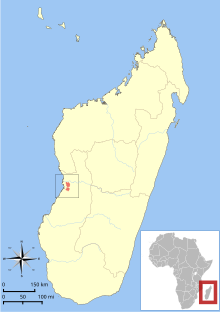Madame Berthe's mouse lemur
| Madame Berthe's mouse lemur | |
|---|---|

| |
| Scientific classification | |
| Domain: | Eukaryota |
| Kingdom: | Animalia |
| Phylum: | Chordata |
| Class: | Mammalia |
| Order: | Primates |
| Suborder: | Strepsirrhini |
| Family: | Cheirogaleidae |
| Genus: | Microcebus |
| Species: | M. berthae
|
| Binomial name | |
| Microcebus berthae Rasoloarison et al., 2000[3]
| |

| |
| Distribution of M. berthae[1] | |
Madame Berthe's mouse lemur (Microcebus berthae) or Berthe's mouse lemur is the smallest of the mouse lemurs and the smallest primate in the world; the average body length is 9.2 cm (3.6 in) and seasonal weight is around 30 g (1.1 oz).[4] Microcebus berthae is one of many species of Malagasy lemurs that came about through extensive speciation, caused by unknown environmental mechanisms and conditions.[5]
This primate is found chiefly in the
This lemur is named after the conservationist and primatologist Berthe Rakotosamimanana of Madagascar, who was the Secretary General of the Groupe d'Etudes et de Recherche des Primates (GERP) from its founding until her death in 2005.[8]
Physical description
Microcebus berthae has short, dense dorsal pelage that is bicolored cinnamon and yellow
Distribution and habitat
Madame Berthe's mouse lemur is known to live in
Because of the high rate of deforestation in the surrounding Menabe forests (52%) between 1985 and 2000, less than 22,000 hectares (54,000 acres) of inhabitable forests remained between Kirindy Park, the Tsiribihina River, and the Reserve. Given that this lemur occurs at 0.36 lemurs per ha, it is estimated that about 7,920 mouse lemurs were left in the area in the year 2000. With
Behavior
Microcebus berthae are typically solitary
In a population of Microcebus berthae, males significantly outnumber females. Despite there being no
Social systems of M. berthae are more similar to the gray mouse lemur (Microcebus murinus) than the fat-tailed dwarf lemur (Cheirogaleus medius), i.e. Madame Berthe's mouse lemur is sexually promiscuous rather than monogamous. The range in distance of males is larger than that of the females in both Microcebus species, both before and after mating seasons. Research has also been conducted on the distribution of sleeping sites, as well as on testes size and the presence of vaginal plugs. Study of capture rates and physiological proof reveals no evidence that M. berthae has a hibernation season, which increases the chances of sexual activity within the species.[10]
Ecology
Mouse lemurs are considered to be a
The reason for the mouse lemur species' mutual avoidance is not yet clearly known. The gray mouse lemur has several competitive advantages over Madame Berthe's mouse lemur. It is about twice as large as Madame Berthe's mouse lemur. It also has the advantages of being a generalist, and having fewer deaths by predation, with 70% predation mortality for Madame Berthe's mouse lemur, vs. 50% predation mortality for the gray mouse lemur. The areas used exclusively by each species share structural characteristics and food sources. Gray mouse lemurs are able to live in more types of vegetation than Madame Berthe's mouse lemur yet have smaller, denser territories. This suggests that their avoidance does not stem from environmental differences, but rather by competitive coexistence.[7]
Diet
Madame Berthe's mouse lemur shares its niche with the sympatric gray mouse lemur (Microcebus murinus). Both lemurs feeding ecology suggests that there is a coexistence behavior between the two lemur species. Both species are found in western Madagascar's highly seasonal dry
Madame Berthe's mouse lemur is an omnivore and mainly feeds on fruits and flowers of different tree and shrub species, insect secretions, gum, arthropods and small
Status
As of December 2019, Madame Berthe's mouse lemur is rated
See also
References
- ^ . Retrieved 18 November 2021.
- ^ "Checklist of CITES Species". CITES. UNEP-WCMC. Retrieved 18 March 2015.
- OCLC 62265494.
- ^ Gron KJ. (11 February 2009). Primate Factsheets: Mouse lemur (Microcebus) Taxonomy, Morphology, & Ecology . Accessed 2009 August
- S2CID 23268852.
- ISBN 978-1-881173-88-5.
- ^ PMID 18574599.
- ISBN 978-0-387-34586-4.
- ^ S2CID 22064830.
- S2CID 41872248.
- ^ S2CID 37601666.

